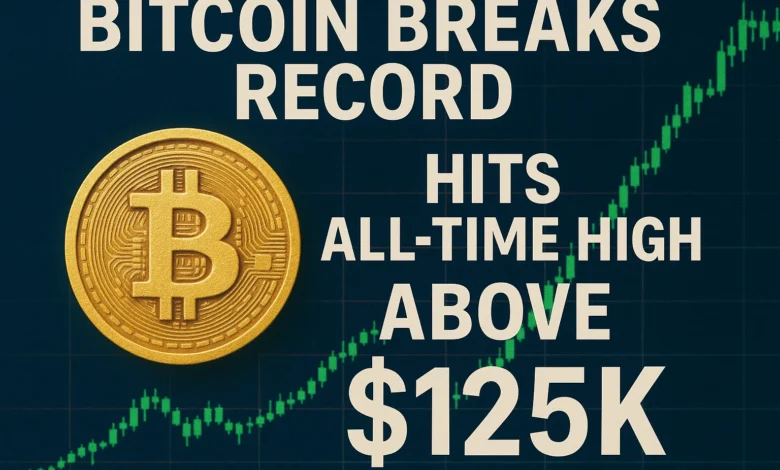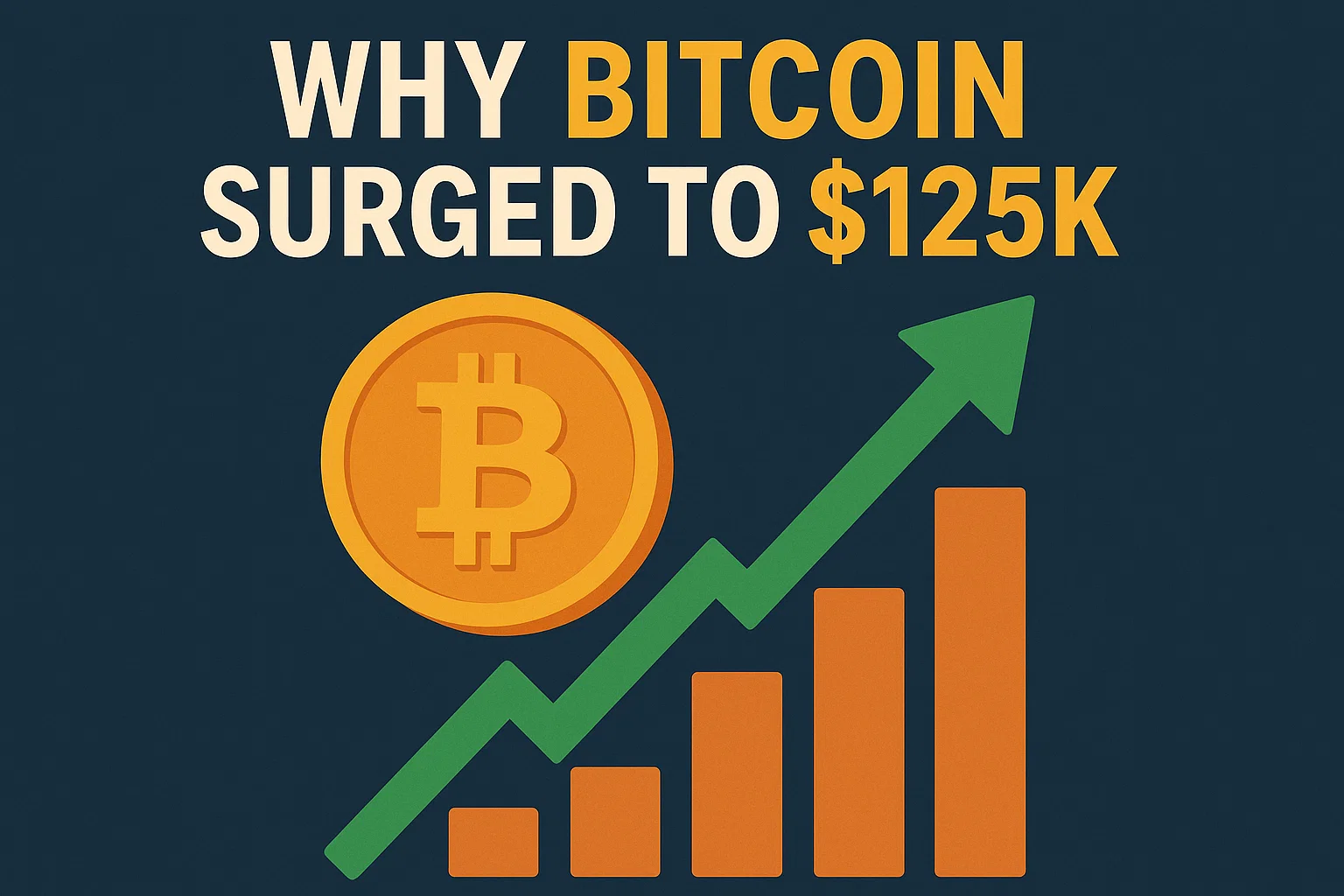Bitcoin Breaks Record Hits All-Time High Above $125K
Bitcoin soars past $125,000, setting an all-time high. Discover why this surge matters, what’s driving it, and what comes next in BTC’s epic rally.

In a breathtaking surge that has electrified the cryptocurrency world, Bitcoin hits an all-time high above $125,000, setting a new historic benchmark for the flagship digital asset. This dramatic rally marks not just another milestone for BTC, but signals a potential shift in how investors and markets view digital currencies. While sceptics may call it exuberance, the ascent reflects fundamental undercurrents—macro forces, institutional flows, regulatory tailwinds, and changing narratives around “digital gold.”
Let’s dig into why Bitcoin Breaks Record Hits at $125,000 matters—and what that means going forward.
What It Means When Bitcoin Reaches a New All-Time High
When Bitcoin surpasses its previous records and sets a new all-time high, the event carries far more significance than a simple price milestone. It represents a shift in market psychology, investor confidence, and broader economic narratives surrounding digital assets.
A Signal of Market Confidence
Crossing $125,000 isn’t just a number — it demonstrates that the market collectively believes in Bitcoin’s long-term viability. Such a surge often indicates that buyers are willing to accumulate at higher levels, suggesting renewed optimism and capital inflows from both retail and institutional participants.
Breaking Psychological and Technical Barriers
Round-number milestones, such as $100K or $125K, act as psychological resistance points. When Bitcoin decisively moves above them, it not only invalidates prior ceilings but also attracts traders who were waiting for confirmation of upward momentum. This can trigger a self-reinforcing cycle of demand.
Amplifying Media and Institutional Attention
Each new record tends to dominate financial headlines and social media feeds. This exposure attracts new investors and legitimises Bitcoin, breaking records and garnering further recognition among traditional financial circles, prompting more institutions to explore crypto allocations or integrate blockchain products.
Strengthening the “Digital Gold” Narrative
As Bitcoin achieves higher valuations, its image continues to evolve — from a speculative digital token to a credible store of value and potential hedge against inflation. The milestone reinforces its comparison to gold as an asset designed to preserve wealth in uncertain economic conditions.
Redefining Valuation Models and Market Forecasts
New highs prompt analysts to update their frameworks, recalibrating risk metrics, revising price targets, and expanding valuation models that incorporate adoption rates, on-chain activity, and macroeconomic factors. Each threshold reached helps refine investors’ understanding of Bitcoin’s fair value and potential upside.
Why Bitcoin Surged to $125K

To understand how Bitcoin reached an all-time high above $125,000, we must examine the intersection of forces driving its upward momentum. Several key drivers are at play:
Macro Tailwinds and the Weakening US Dollar
A prominent catalyst is the weakness in the U.S. dollar. In 2025, the dollar has been on a downward trend, with analysts predicting its worst year since 1973 in relative performance. As sovereign debt levels rise and inflation pressures persist, investors are eyeing alternative stores of value.
Bitcoin, with its fixed supply and borderless nature, benefits from this structural narrative. Moreover, soft inflation prints, expectations of interest rate cuts, and fiscal uncertainty have conspired to erode dollar strength—creating a backdrop for risk assets, including crypto, to rally.
Institutional Inflows and ETF Momentum
One of the most significant developments in 2025 has been the influx of institutional capital through Bitcoin exchange-traded funds (ETFs). These vehicles allow major funds, pension plans, and wealth managers to gain exposure to BTC without the complexity of custody.
As ETF inflows accelerate, they provide sustained demand for the underlying Bitcoin. Corporate treasuries, hedge funds, and even sovereign allocations are now more willing to hold Bitcoin on balance sheets, further tightening supply in the spot markets.
Regulatory Environment and Policy Signals
Regulation plays a massive role in sentiment. In the United States, the signing of the Strategic Bitcoin Reserve and the GENIUS Act signals that government policy is becoming more constructive toward digital assets. Such policy signals reduce uncertainty, encouraging capital inflows and institutional appetite.
Additionally, favourable rulings, clearer frameworks for custodial services, and regulatory relief in key jurisdictions have lowered barriers to entry for mainstream players. The narrative is shifting away from “crypto is the wild west” toward “crypto is a regulated, asset-class worthy of capital.”
On-Chain Dynamics and Supply Constraints
On-chain metrics, such as miner reserves, exchange outflows, and accumulation by long-term holders, are also telling. As prices rise, some miners and short-term holders may sell, but many choose to hold, thereby shrinking the available supply.
Meanwhile, accumulated demand from institutions and retail reduces selling pressure. Forced liquidations of short positions can amplify upward moves in highly leveraged markets. As Bitcoin passed $124,000 and approached $125,000, some analysts observed massive short liquidations fueling momentum.
Technical View: Is the Rally Sustainable?
While momentum is strong, the technical and structural landscape merits scrutiny.
Trend Confirmation and Support Zones
The breakout above prior resistance near $123–124K is a critical confirmation. When prices retest support zones above that level and hold, it strengthens confidence in continuation. Analysts are watching the $ 123,000 to $ 124,000 zone as the new floor. If Bitcoin successfully uses that zone as support, the path toward higher levels becomes more credible. Otherwise, a reversion to lower levels remains possible.
Resistance Ahead and Price Projections
Where does Bitcoin go from here? Some banking institutions and analysts now project targets of $135,000, $150,000, or even $200,000 by year-end, assuming momentum and macro conditions persist. However, resistance may emerge along the way, particularly as profit-taking intensifies, volatility increases, or macro data surprises. Technical indicators, such as RSI / MACD, may indicate overbought conditions, signalling potential pullbacks.
Correction Risk and Volatility
Bitcoin’s history is littered with sharp corrections following parabolic runs. Even if the broader trend remains bullish, short-term pullbacks of 10%–20% are possible—and even healthy. Maintaining a disciplined framework and risk control is essential in this environment. Given the rapid run-up, consolidation phases or sideways drift might emerge before another leg upward can occur. Watch for support between $110,000 and $125,000 if the market retraces.
Looking Ahead: Scenarios and Probabilities for Bitcoin’s Path Forward
Based on current technical structures, market sentiment, and macroeconomic indicators, several potential trajectories for Bitcoin’s performance can be envisioned over the coming months:
Base Case – Continued but Moderate Bullish Trend
In this most probable scenario, Bitcoin consolidates within the $123,000–$135,000 range as it digests previous gains and establishes a new support base. Once market stability is confirmed and buying momentum resumes, BTC could stage another leg higher, potentially targeting the $150,000 level by year-end. This scenario assumes steady institutional inflows and a neutral to supportive macroeconomic backdrop.
Upside Acceleration – Extended Bull Run
Under conditions of strong macro tailwinds, such as favourable monetary policy signals, continued ETF inflows, and renewed speculative enthusiasm, Bitcoin could experience a momentum-driven surge. In this case, the price could advance rapidly into the $150,000–$200,000 range, fueled by both institutional and retail participation, as market psychology shifts toward euphoria.
Rangebound Consolidation – Cooling After the Rally
Following a decisive upward move, Bitcoin may enter a sideways trading phase, oscillating within a broad range as traders lock in profits and markets recalibrate. This consolidation period could last for several months, providing time for on-chain metrics and liquidity conditions to normalise before the next directional move.
Pullback or Correction Scenario – Downside Risk
A failed breakout, unexpected regulatory developments, or adverse macroeconomic events could trigger a corrective phase. In such a case, Bitcoin may retrace toward the $110,000–$120,000 support zone, allowing long-term investors to reaccumulate at lower levels before the broader uptrend potentially resumes.
Conclusion
The moment Bitcoin Breaks Record and hits a High of above $125,000 is a watershed event in the history of cryptocurrencies. It marks more than just a numerical milestone—it displays evolving narratives around institutional adoption, macro hedging, policy alignment, and shifting investor psychology.
While the path ahead is unlikely to be smooth, current signals suggest an environment ripe for continuation—if underpinned by discipline and prudent risk management. For both seasoned and new participants, the key becomes balancing enthusiasm with caution. Bitcoin’s ascent to $125,000 opens new horizons—but also demands respect for volatility, structure, and uncertainty.
As Bitcoin carves out this new frontier, the coming weeks and months will be critical. Will it continue to rise, pause to consolidate, or undergo a correction? The answer will reveal a great deal about where the crypto era is headed next.
FAQs
Q: Why did Bitcoin break above $125,000 now?
Bitcoin’s milestone reflects a confluence of factors, including weakness in the U.S. dollar, increased institutional investment via ETFs, favourable regulatory signals, and on-chain supply constraints. The inflows and momentum created a tipping point for the breakout above $125K.
Q: Is this rally sustainable or just a bubble?
While the pace is aggressive and the risk of correcting is real, many structural changes differentiate this rally from pure speculation. Institutional adoption, regulatory clarity, and macro tailwinds support sustainability—but short-term volatility and corrections remain possible.
Q: What are realistic price targets following this new high?
Analysts propose targets like $135,000, $150,000, or even $200,000 by year-end, assuming continued momentum. However, price action may face resistance and take time to reach higher targets.
Q: What downside risks should investors monitor?
Key risks include regulatory reversals, macro surprises (e.g., inflation, rate hikes), profit-taking pressure, technical breakdowns, and liquidity constraints at higher levels. These could trigger pullbacks or extended corrections.
Q: How should new investors approach this new all-time high?
New entrants should consider risk management strategies, including using dollar-cost averaging, limiting exposure, defining position sizes, and resisting FOMO. It’s also helpful to focus on a medium- to longer-term time horizon and avoid chasing extremes without a tactical plan.
See More: Crypto Market Wipes Out September Gains as Bitcoin Barely Holds









